
Ōmachi is a city located in Nagano Prefecture, Japan. As of 1 March 2019, the city had an estimated population of 27,559 in 11861 households, and a population density of 49 persons per km2. The total area of the city is 565.15 square kilometres (218.21 sq mi).

Fuji Five Lakes is the name of the area located at the base of Mount Fuji in the Yamanashi Prefecture of Japan. It has a population of about 100,000 and sits about 1,000 meters (3,300 ft) above sea level. The name Fuji Five Lakes comes from the fact that there are five lakes formed by previous eruptions of Mount Fuji. The principal city in the region, Fujiyoshida, has a population of roughly 54,000 and is particularly famous for its udon noodles. Another point of interest is Aokigahara Jukai Forest. The Fuji Five Lakes was selected by the Tokyo Nichi Nichi Shimbun and Osaka Mainichi Shimbun as one of the Twenty-Five Winning Sites of Japan in 1927.

Lake Okutama is in Tokyo and Yamanashi Prefectures in Japan. Lying above the Ogōchi Dam, it is also known as the Ogōchi Reservoir. Lake Okutama is an important source of drinking water for Tokyo.

The Ishikari River, at 268 kilometres (167 mi) long, is the third longest in Japan and the longest in Hokkaidō. The river drains an area of 14,330 square kilometres (5,530 sq mi), making it the second largest in Japan, with a total discharge of around 14.8 cubic kilometres (3.6 cu mi) per year.
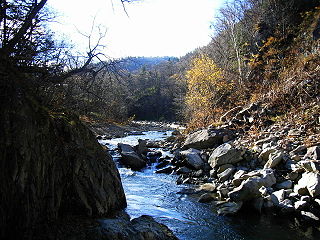
The Toyohira River is a river in Hokkaidō prefecture, Japan. It is 72.5 km in length and has drainage area of 894.7 km². It is a tributary of the Ishikari River.
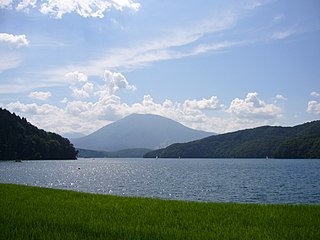
Lake Nojiri is in the town of Shinano, Kamiminochi District, Nagano Prefecture, Japan. Second to Lake Suwa among lakes in Nagano Prefecture, Nojiri is a resort, the location of the first pumped-storage hydroelectricity in Japan, and the site of a Japanese Paleolithic excavation.

The Tateyama Kurobe Alpine Route is a mountain sightseeing route between Tateyama, Toyama and Ōmachi, Nagano, Japan. Opened on June 1, 1971, it is 37 kilometres (23 mi) long, with a difference in elevation of as much as 1,975 metres (6,480 ft).

The Sameura Dam is a dam on the Yoshino River on the island of Shikoku, Japan, completed in 1975. It has the largest storage capacity in Shikoku. The dam holds back a reservoir, named Lake Sameura

Nozori Dam (野反ダム) is a dam located in the town of Nakanojō, Agatsuma District, Gunma Prefecture, Japan. It is a hydroelectric dam operated by Tokyo Electric Power Company.The lake created by the dam is known as Lake Nozori.
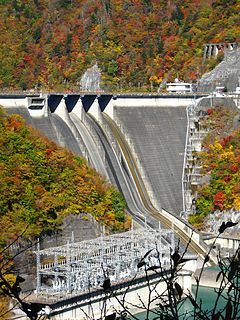
The Hatanagi-I is a dam on the Ōi River in Aoi-ku, Shizuoka, Shizuoka Prefecture on the island of Honshū, Japan. With a height of 125 metres (410 ft), it is the tallest hollow-core concrete gravity dam in the world. It has a hydroelectric power generating station owned by the Chubu Electric Power Company. It supports a 137 megawatts (184,000 hp) pumped-storage hydroelectric power station.

Akan River is a river in Hokkaidō, Japan.

Lake Akan is a lake in Kushiro, Hokkaidō, Japan. It is located in Akan National Park and is a Ramsar Site.

The Miyagase Dam is a dam on the Nakatsu River, a main tributary of the Sagami River in Aikō District, Kanagawa Prefecture, Japan. It straddles the border between the village of Kiyokawa, town of Aikawa and the former town of Tsukui.
Supung Lake(수풍저수지) is an artificial reservoir on the border between North Korea and China. The lake has been created by a damming of the Yalu River by the Sup'ung Dam, located just upstream from Sinuiju, North Korea.

Tase Dam is a multipurpose dam located on the Sarugaishi River in the former town of Tōwa which is now a part of the city of Hanamaki in Iwate Prefecture, in the Tohoku region of northern Japan. Completed in 1954, it is managed by the Tohoku Regional Development Bureau of the Ministry of Land, Infrastructure and Transport. Located on the Sarugaishi River, a branch of the Kitakami River, it is the first of the dams completed as part of the Kitakami Area Comprehensive Development Plan (KVA). The dam creates Lake Tase, a popular sightseeing spot.

Okuno Dam is a multi-purpose dam on the Itō-Ōkawa River, located in Itō, Shizuoka, Japan.
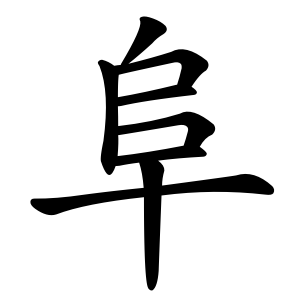
Radical 170 or radical mound (阜部) meaning "mound" or "dam" is one of the 9 Kangxi radicals composed of 8 strokes. This radical character transforms into 阝 when used as a left component.
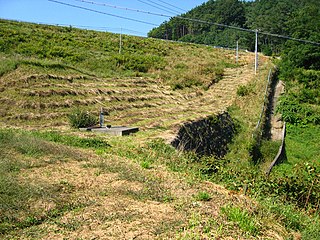
Lake Misuzu Dam is a dam in Matsumoto, Nagano Prefecture, Japan, completed in 1951.
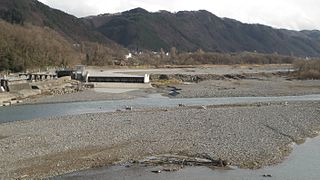
Saigawa Dam is a dam in Nagano Prefecture, Japan on the Sai River. Its lake is also known as Swan Lake for the swans that come every winter.


















